Day 2 of a weekend of Brecks & Coast Tours. We would spend the day up on the North Norfolk coast today, looking for lingering winter visitors and early spring migrants. It was another lovely sunny day, but cooler than yesterday in an increasingly gusty westerly breeze.
Our destination for the morning was Holkham. As we drove up along Lady Anne’s Drive, we could see a few ducks around the pools beside the road, mainly Shoveler and a few Wigeon. Three Little Egrets flew across as we parked and we could see a Grey Heron at the back of the grazing marsh as we got out.
There was a keen wind blowing across, so after donning an extra layer, we scanned the grass. There were lots of Curlew in the next field over and a Lapwing started singing nearby. A couple of distant Marsh Harriers and a Common Buzzard circled low over the marshes.
A small bird out in the short grass caught our eye. It was a Wheatear, a smart male with grey back and black bandit mask. A migrant stopped off here to feed on its way north. As we walked up towards the pines, we could see lots more small birds in the grass the other side. These were Meadow Pipits, there were at least 30 of them, again probably migrants which had broken their journey here. There were two Pied Wagtails too, but hard to tell whether these were migrants or local birds here.
It was a big high tide this morning and when there is standing water on the saltmarsh the Shorelarks can be elusive. So we planned to walk west first down to the hides. We hadn’t gone very far when we heard a Chiffchaff singing from the top of a hawthorn bush next to the path. It flew up into the first of the poplars and we stopped to look at it, the earliest of our returning breeding warblers.

Just at that moment, we received a message to say that five of the Shorelarks were out on the beach, so we turned round and headed straight out there to try to see them. As we walked east along the edge of the saltmarsh, there were not many birds, possibly due to the high tide or the number of people out walking their dogs. A small flock of 16 Pink-footed Geese flew west overhead, possibly birds heading off on their way back to Iceland for the breeding season.
As we got to the cordon, we had still not managed to find the Shorelarks. There were four Ringed Plovers out on the short vegetation the other side of the rope and a couple of Meadow Pipits. A Tawny Owl hooted from the pines, despite it being the middle of the morning. After scanning all around with no joy, we decided to make our way out to the beach. But there was still a lot of water on the sand over towards the dunes and it was too wet for anyone without wellies to cross, so we turned to head back.
As we walked back alongside the cordon fence, we looked out across the saltmarsh again and noticed two birds out the in the low vegetation over towards the pines. Shorelarks! We hurried round and it was good that we did. We all managed to get a good look at them in the scope, noting their yellow faces and black masks. Then two dog walkers set off right out across the middle of the saltmarsh, taking a short cut to the beach, and flushed them. The Shorelarks flew out over the dunes and appeared to drop down to the beach beyond.
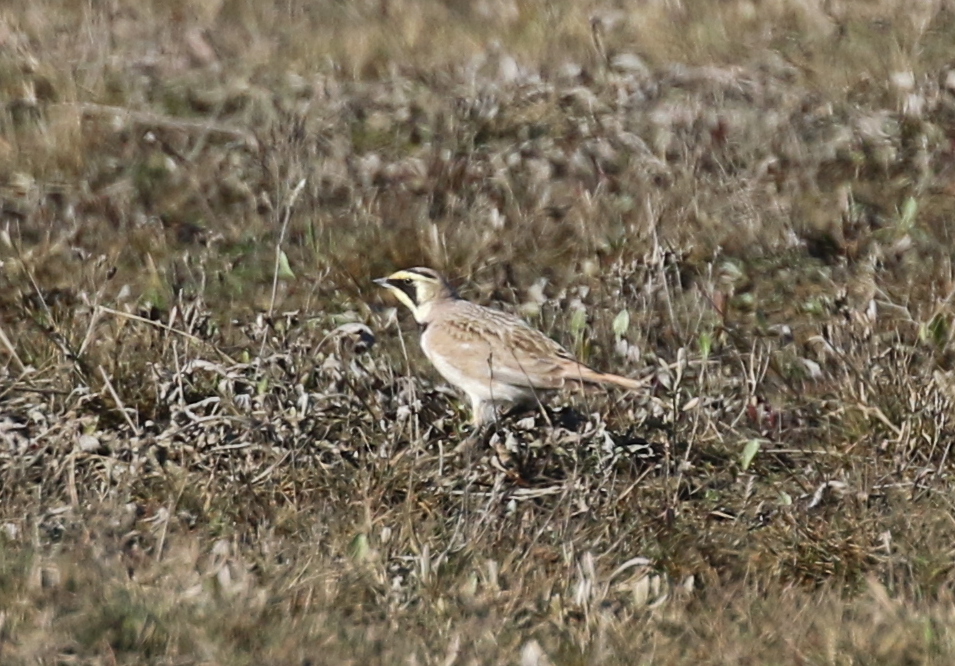
We were still standing on the path when we noticed four more people walking right through the middle of the saltmarsh. Presumably they had flushed another three Shorelarks, because we saw them flying round with a couple of Skylarks. They landed on the saltmarsh in front of us, but a bit further back than the earlier two. At least now, we could get some more prolonged views of them in the scope.
While we were watching the Shorelarks, a Red Kite drifted west along the pines behind us, then out across the saltmarsh to the dunes. As we started to walk back, we looked across to the dunes and saw another raptor out there. It wasn’t the Red Kite this time – it was a Hen Harrier. It was a ringtail and we could see the white square at the base of its tail as it quartered back and forth over the dunes, presumably trying to flush pipits from the grass.
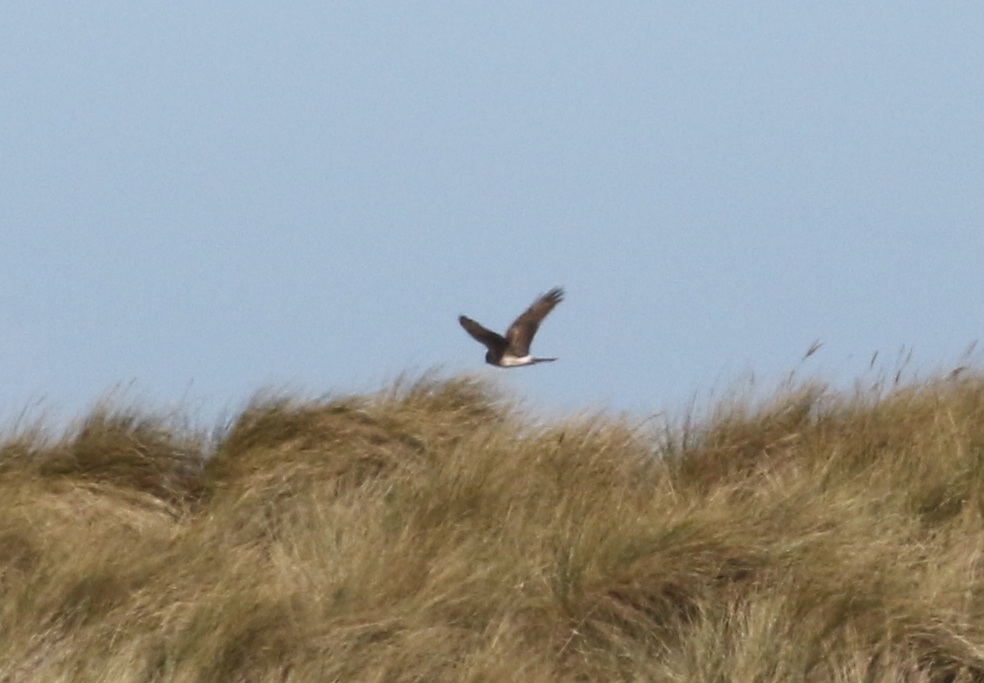
After flying up and down through the dunes for a couple of minutes, the Hen Harrier continued on its way west. It cut across the saltmarsh at the Gap, before flying up and over the pines. We made our way back that way too. When we got back to Lady Anne’s Drive and had a quick stop to use the facilities at The Lookout café, we could see that the Meadow Pipits which had been out on the grass earlier had moved on.
As we resumed our earlier aborted walk west on the inland side of the pines, we stopped to admire a flock of tits in the trees. There were lots more Chiffchaffs singing in the trees further along the path – they had arrived in force now. With the air warming up, the Common Buzzards were circling up now calling.

We stopped for a quick look at Salts Hole. Three Tufted Ducks were busy diving over towards the back and a Little Grebe was doing the same in front of the reeds on the side. Scanning the grass out beyond, we spotted two Mistle Thrushes collecting nest material. Four Red Deer were out on the marshes just the other side of Meals House.
Other than the Chiffchaffs, there were not many other migrants or other signs of fresh arrivals until we got almost to the crosstracks. We could hear the cracking of the opening cones in the sunshine and we looked up into the pines to see several Bramblings feeding on the released seeds. There were a few Siskins in the trees too. They had presumably stopped off here for a last feed up before heading out over the North Sea. One or two of the Bramblings were singing their wheezing song too.
As we walked up towards Joe Jordan Hide we could already see a Great White Egret on the marshy edge of one of the pools in front. We had a better view from up in the hide.
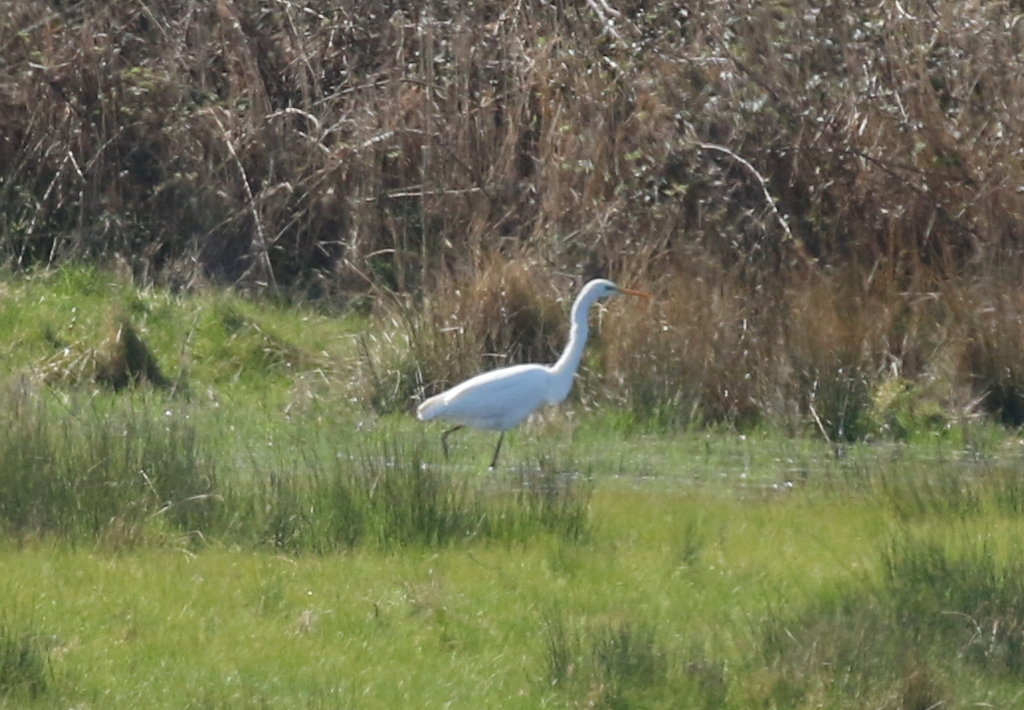
A Spoonbill dropped down to bathe in the water. Through the scope, we could see its yellow-tipped black spoon-shaped bill and its bushy nuchal crest, indicating it was a breeding adult. There are quite a few Spoonbills back now and we had expected a bit more activity from them today, but this was the only one we saw while we were sitting in the hide. After a good wash and brush up, it flew back up into the trees.
There were lots of Cormorants up in the trees too. Several Avocets were feeding up to their bellies in the deep pools. Occasionally a Marsh Harrier would drift across. There were lots of Greylag Geese out on the marshes and looking through them carefully, we could see two smaller geese in with them. They were Pink-footed Geese – when they looked up from feeding we could see their dark heads and smaller, mostly dark bills.
By the time we got back to Lady Anne’s Drive, we were feeling hungry so we stopped for an early lunch at The Lookout café. Afterwards, we headed along the coast to Titchwell for the afternoon.
A quick look at the feeders in front of the Visitor Centre at Titchwell revealed only Chaffinches and a few tits. But round the other side a Brambling was feeding on the seeds with the Chaffinches and Goldfinches and a Greenfinch dropped in too. Out onto the main path, and a quick scan produced a Water Rail feeding down in the ditch.
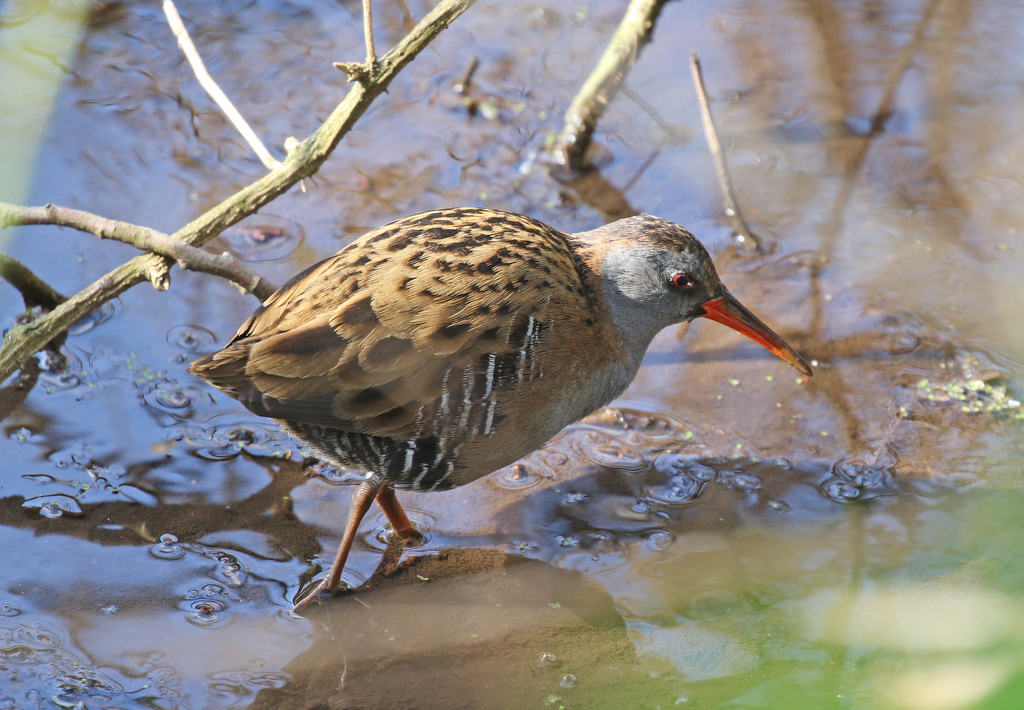
We had heard Mediterranean Gulls flying over the Visitor Centre, but once we got out of the trees we could see them flying in and out of the freshmarsh, heading inland to feed in the fields. Against the light, we could see their translucent white-tipped wings, very different from the Black-headed Gulls which were also flying in and out with them.
The Water Pipits have been mostly on the old pool on Thornham grazing marsh in the last week or so, but when we stopped to look for them we couldn’t see one at first. We tried a different angle from a bit further up and one of the group spotted something appear from behind the reeds down at the front. It was the Water Pipit.
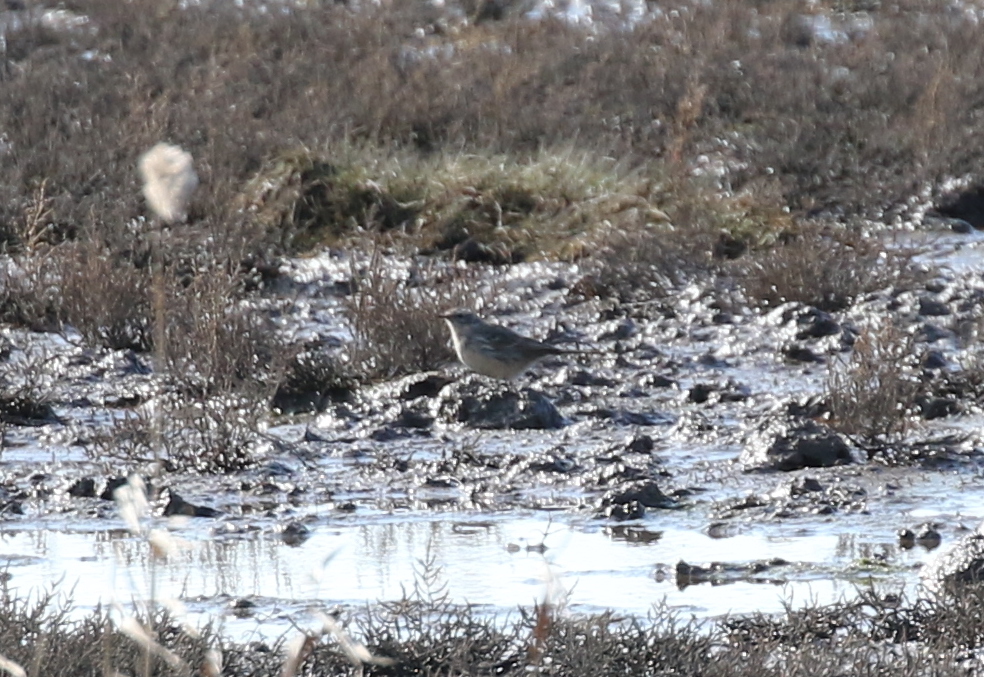
With the vegetation growing up on the old pool here now, it was hard to see at times, but we all eventually had a good look at the Water Pipit through the scope. It is starting to moult into summer plumage now and was looking distinctly pink-tinged on the breast, with much reduced streaking.
While we were watching the Water Pipit, a large flock of Golden Plover flew over. They had probably been disturbed from the fields where they were feeding by something and were zooming round at speed, twisting and turning, their underparts flashing white in the sun as they banked. At one point, they came low over our heads and all we could hear was the whooshing of lots of beating wings. A little further on, several Common Pochard were diving in one of the reedbed channels.
In the Visitor Centre earlier, we had been told that some Bearded Tits had been showing well by the path today. With the breeze having picked up considerably, we didn’t fancy our chances but as we walked along the path we heard a couple of Bearded Tits calling to each other. Then we just glimpsed one as it flew across the small pool below the path and disappeared into the reeds at the back.
We stood to watch and a female Bearded Tit appeared low down in the reeds. It was hard to see in the vegetation at first, but then climbed up and perched in full view. When it turned side on, we could see its long tail. Then it flew towards us over the water and disappeared down behind the reeds in front.
That was great – it is always nice to actually see a perched Bearded Tit rather than just a long tail disappearing over the reeds – but the male is the big prize, with its powder blue-grey head and long black moustaches. Another Bearded Tit appeared working its way through the reeds at the back of the pool, low down just above the water, another female, and while we were looking at it we realised it was being followed by a male.
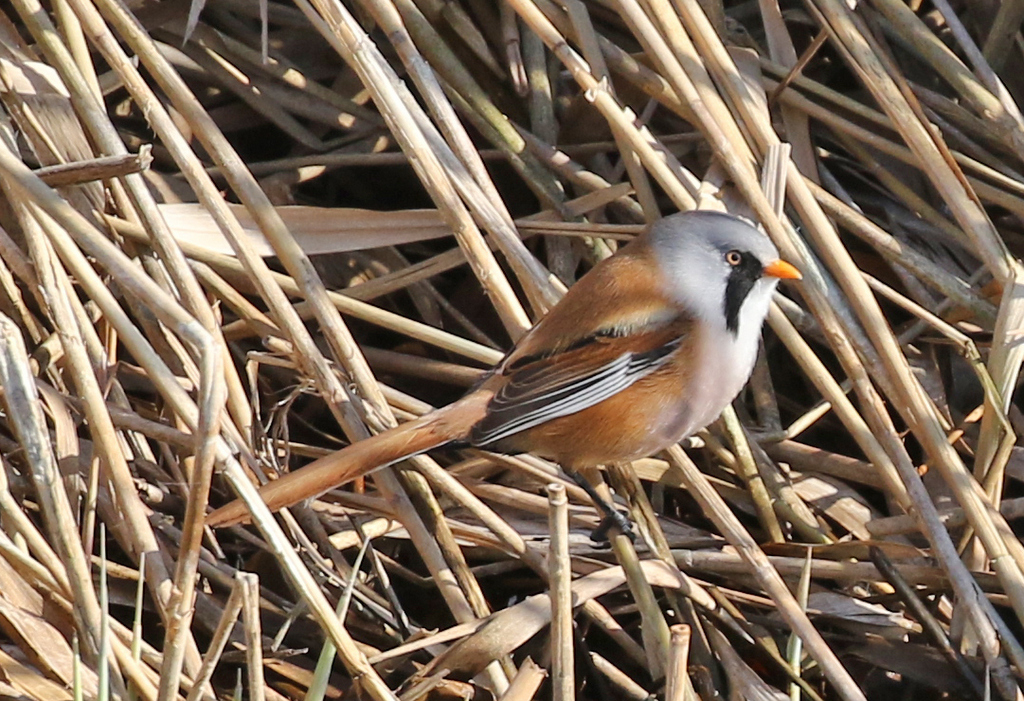
Some of the reeds around the pools here have just been cut, so the Bearded Tits were coming right out into the open. They were climbing up through the piles of cut reed and then dropping down to the water, climbing about in the cut reed stems and picking at the water surface. We had some fantastic views of them today! Eventually, the pair of Bearded Tits flew across and disappeared into the reeds below the bank too, so we decided to move on.
The water level on the Freshmarsh has dropped a little but is still fairly high, which means there are still not many exposed islands. Great for ducks! Several Teal were feeding in the shallower water just below the bank, including some smart drakes which we stopped to admire. A little further back, there were pairs of Shoveler scattered liberally about, mostly swimming in circles with their heads under the water and their long shovel bills hidden from view. There were a few Gadwall too and chattering flocks of Brent Geese were commuting back and forth from the saltmarsh the other side of the bank.
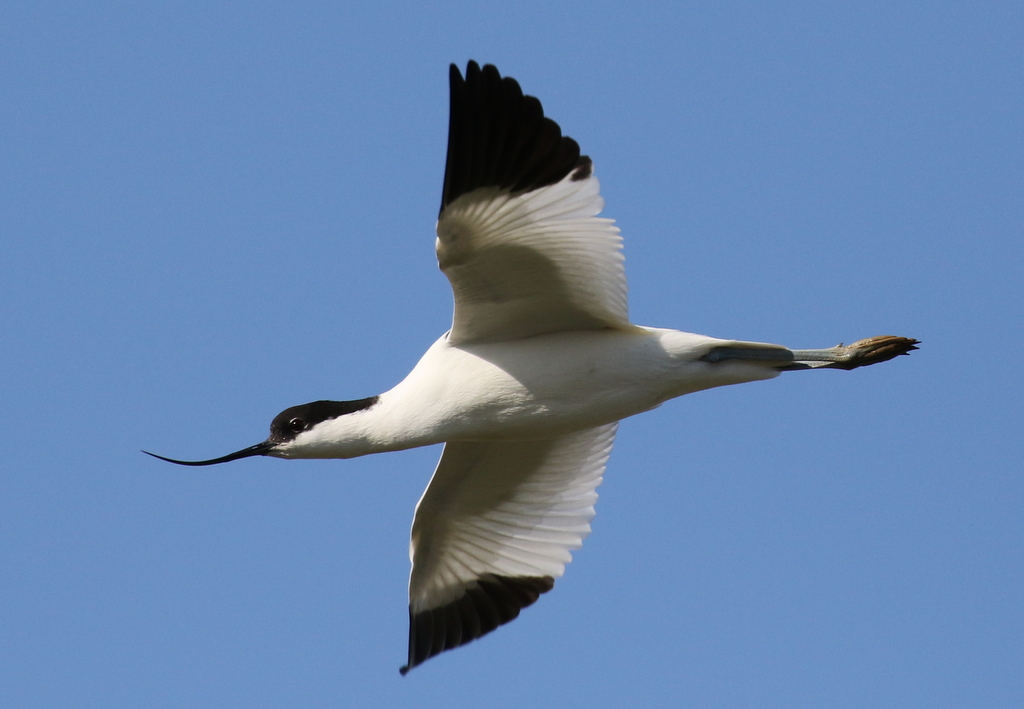
There are lots of Avocets back here now and several of those were flying in and out from the Thornham saltmarsh to feed too. Others were feeding up to their bellies in the deep water on the Freshmarsh. A small flock of Knot had flown in to rest in the shallower water by the small island by the junction to Parrinder Hide. We had a look at them through the scope, before they were off again, over the bank to Volunteer Marsh to feed.
A little further back, a flock of Black-tailed Godwits was also roosting. With their longer legs, they could rest in the slightly deeper water. Some of them are now starting to moult into breeding plumage and their were several smart rusty birds amongst the mostly grey-brown winter individuals in the group. Further back still, there were five Ruff around the pile of bricks which normally sits on one of the other islands, but which is still under water. Through the scope, we could see their scaly-patterned backs.
Continuing on to Parrinder Hide, we got the scope on a pair of Mediterranean Gulls in with all the Black-headed Gulls loafing around in front of the hide. It was great to see them on the ground together, so we could get a better look at the Mediterranean Gulls’ jet black heads with bright white eye rings, heavier and brighter red bills and bright white wing tips. There were lots more Mediterranean Gulls in with all the Black-headed Gulls on the fenced off ‘Avocet Island’ further back, which the gulls have now annexed as a breeding colony.
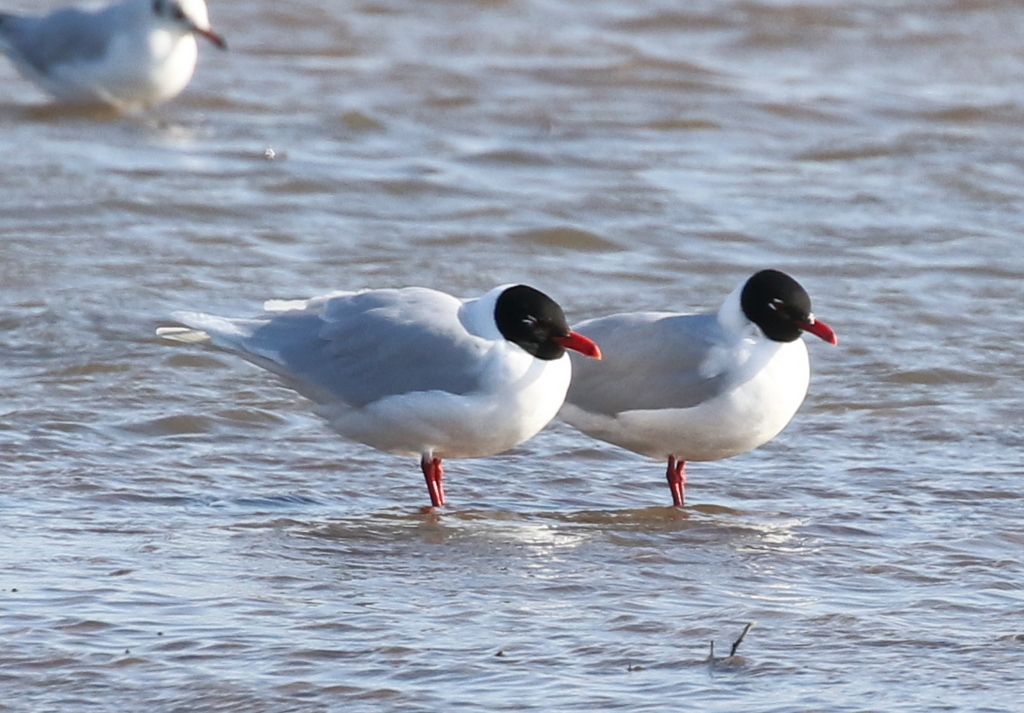
Back on the main path, we stopped to scan the Volunteer Marsh. The tide was out now, but having been covered by water earlier it was obviously attractive to the Knot which were now feeding in and out of the patches of vegetation. A Curlew at the front managed to extract a long worm out of the mud and took it over to wash it in a rather muddy puddle! There were a couple of Redshanks down in the channel too.
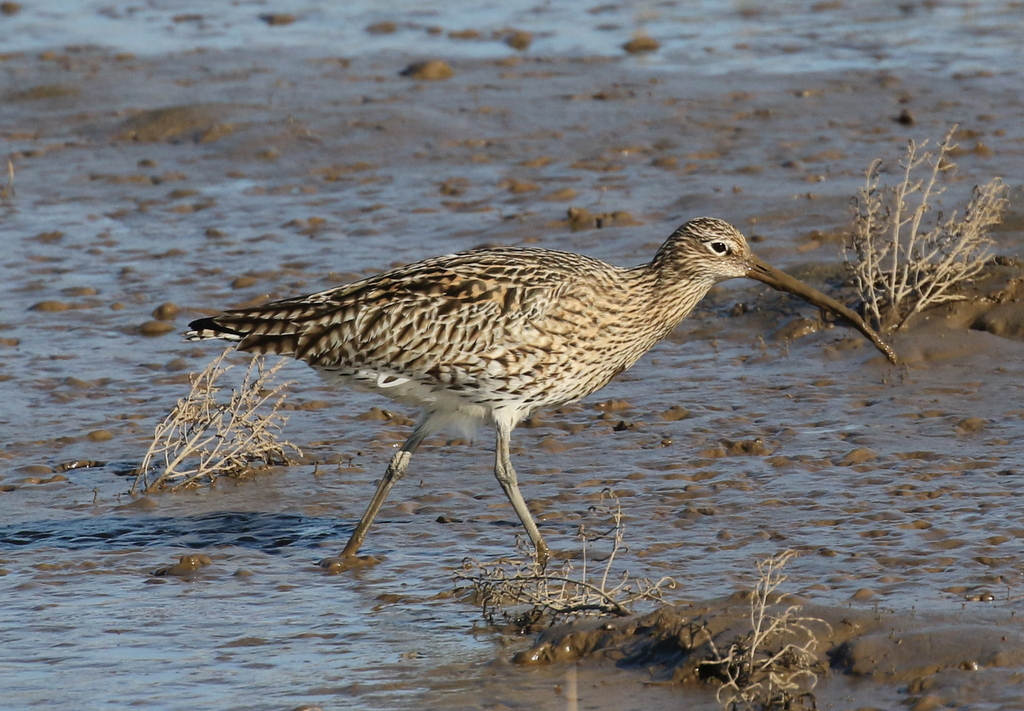
The no longer tidal ‘Tidal Pools’ were very full of water now and rather devoid of any birds, so we continued straight on out to the beach. With it being a big tide, the water was a long way out now, so we walked down to the concrete blocks to scan the sea.
There were a couple of other people there who had just spotted a diver offshore. We managed to get it in the scope and confirmed it was actually a Black-throated Diver, the rarest of the three regular species off here. Otherwise, all we could find out on the sea were a few Great Crested Grebes but as well as being low tide it was very choppy now in the wind. Two brown female Eider flew past offshore.
It seemed like we might be better off looking for waders here and we really wanted to see Bar-tailed Godwit. With the water a long way out, there were just Oystercatchers feeding on the mussel beds, which were well above the tideline now. All the other waders were feeding out on the sand to the west, closer to the sea, so we walked down for a better loon.
We quickly found a couple of Turnstones and one or two Sanderling running along the shoreline. Then scanning along the water’s edge, we located our first Bar-tailed Godwit. It was still in non-breeding plumage, but through the scope we could see its distinctive dark-streaked upperparts, slightly upturned bill and comparatively short legs. Further over, there were more godwits, plus Grey Plovers and a little group of Dunlin feeding on the shore with some more Knot for comparison.
It was rather exposed and windy out on the beach, so we decided to walk back. We swung round via Meadow Trail to Patsy’s Reedbed on our way. There was no sign of any snipe down at the front today, which we were hoping to see, but there were one or two Marsh Harriers hanging in the breeze over the reeds.
Unfortunately it was time to call it a day now too. By the time we got back to the van, everyone was suitably tired out after a great couple of days birding. Time to head for home.
















